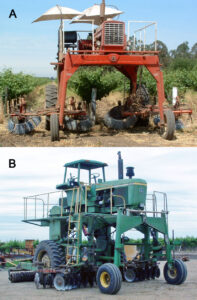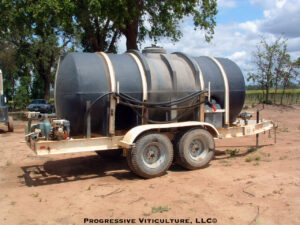 DECEMBER 15, 2017. BY STAN GRANT, VITICULTURIST.
DECEMBER 15, 2017. BY STAN GRANT, VITICULTURIST.
For several decades, the number of mechanized operations in winegrape vineyards has steadily increased. The main driver for mechanization has been the need for increased operational efficiency. Simply mechanizing an activity, however, does not ensure optimum efficiency. Rather, it requires careful decisions and actions designed to meet that goal.
As a first step, a vineyard manager needs to determine if mechanized equipment ownership makes financial sense. While even small vineyard operations benefit from owning basic equipment for timely mowing, shredding, tilling, and spraying, equipment rental or hiring a customer operator is often the most cost-effective option for very expensive, seldom used, or highly specialized equipment.
Below are some other management principles that can promote the operational efficiency of the vineyard equipment you control.
Select Mechanized Vineyard Equipment for Efficiency
Choose equipment appropriate for the task. For example, a rotary mower works well for maintaining turf-type cover crops, but a flail mower is usually more effective for mowing the dense tissues of mature cereal grains, brassicas, and many legumes, as well as for shredding prunings.
For minimizing downtime for repairs, simpler equipment is usually better. While power harrows and rotary cultivators may leave pristine, smooth soil surfaces between vine rows, a tandem disk with a ring roller is typically more reliable.
Before purchasing, evaluate equipment components for durability and function. A vine sprayer with a polyethylene tank and hydraulic agitation may have a low price tag, but a sprayer with a stainless steel tank and mechanical agitation will last longer and often perform more consistently.
Purchase equipment from manufacturers and dealers you can rely on. A little due diligence on equipment sources before a purchase can ensure a quality product with a meaningful warranty that best meets your needs and access to parts and services to keep it working.

Figure 1: A tractor oversized for the task of vine canopy hedging is inefficient. (Photo source: Progressive Viticulture©).
Use a tractor appropriate for the task. While a 100-horsepower tractor may be efficient for disking, it will consume more fuel and provide no performance advantage for herbicide spraying compared to a 25-horsepower tractor or an all-terrain vehicle (ATV)(Figure 1). Conversely, overloading a tractor or working at excessive speeds accelerates equipment wear, increases failures, and lowers efficiency.
Maintain Mechanized Vineyard Equipment for Efficiency
To minimize downtime, regularly clean, adjust, and maintain equipment. Before each use, carefully inspect equipment condition, including tires, lug bolts, fasteners, air filters, and fluid levels. Also, ensure U-joints and bearings are properly lubricated. Change fluids and perform other maintenance measures according to the manufacturer’s schedule to limit efficiency-robbing breakdowns and repair costs, and to keep warranties in effect. To extend equipment life and limit repairs, shelter unused equipment.
Ensure proper tire inflation before entering a vineyard. Overinflated tractor tires have undersized footprints and spin excessively. This has several negative effects, including poor traction, high fuel consumption, accelerated tire and tractor wear, and increased soil compaction. Inflation can damage tire castings and risk tire failure, as well as diminishing tractor maneuverability. Most tractor tire manufacturers have tables and some have apps to help you determine the appropriate tire pressure based on tractor weight, task, and speed.
Use Mechanized Vineyard Equipment for Efficiency
Highly efficient vineyard equipment use is possible only with proficient operators and proficiency requires training. Every operator ought to be competent in equipment driving, maintenance, and task execution. In addition, they need to ensure attachments are properly set, calibrated, or otherwise adjusted before beginning a job.
Equipment turns at the end of vine rows provide no direct benefit to a vineyard operation, while at the same time, they consume time, and fuel, and increase wear. So, machine operations ought to be planned to minimize turning and the length of turns. Where feasible, pass through more than one block before turning and use driving patterns that avoid deadhead runs through or around vineyards.

Figure 2: Performing two tasks (berm sweeping and mowing) per vineyard pass for increased operational efficiency. (Photo courtesy of Rears Manufacturing Company. Used with permission.).
Where workable, multitask mechanical operations. For instance, sweeping berms and shredding prunings are two tasks that work well together (Figure 2). Canopy hedging and disking are another common combination.

Figure 4: Over-the-row tractors reduce passes through vineyards for berm sweeping (A) and disking (B). (Photo source: Progressive Viticulture©).

Figure 3: Multiple-row vine sprayers (A) and herbicide sprayers (B) increase efficiency. (Photo source: Progressive Viticulture©).
Using equipment that treats more than one vine row at a time also increases equipment efficiency. This includes vineyard sprayers with towers and/or booms that apply materials to two or more rows per pass (Figure 3). Some larger vineyard operations have over-the-row tractors that can mow, disk, berm sweep, or dust two rows simultaneously (Figure 4).
Well-designed fill stations with overhead plumbing or nurse tanks with agitation and quick couplers minimize load times and enhance the efficiency of spraying (Figure 5). Also, using a sprayer with the largest practical tank limits refill downtime. For both wet and dry materials, precision application, whether varying the application rate or treating only parts of a vineyard according to need, is another way to increase benefits per unit of machine time.

Figure 5: A nurse tank reduces sprayer load times for large spray jobs. (Photo source: Progressive Viticulture©).
In summary
Maximum efficiency of mechanized vineyard operations requires thoughtful consideration of options for acquiring equipment, followed by careful equipment selection, maintenance, and utilization.
A version of this article was originally published in the Mid Valley Agricultural Services December 2015 newsletter, and was modified and updated for this blog post.
Further Reading
Borgman, DE. Fundamentals of machine operation: Tractors. Deere and Company, Moline, Il. 1981.
Hunt, D. Farm power and machinery management. 8th ed. Iowa State University Press, Ames. 1983.
Kay, RD; Edwards, WM. Farm management. 3rd ed. McGraw-Hill, New York. 1994.
Have something interesting to say? Consider writing a guest blog article!
To subscribe to the Coffee Shop Blog, send an email to stephanie@lodiwine.com with the subject “blog subscribe.”
To join the Lodi Growers email list, send an email to stephanie@lodiwine.com with the subject “grower email subscribe” or click on “join our email list” to the right.
To receive Lodi Grower news and event promotions by mail, send your contact information to stephanie@lodiwine.com or call 209.367.4727.
For more information on the wines of Lodi, visit the Lodi Winegrape Commission’s consumer website, lodiwine.com.


